https://www.youtube.com/watch?v=7o-B1S6JI6s&nohtml5=False
https://www.youtube.com/watch?v=uIk_N3JfH6I&nohtml5=False
https://www.youtube.com/watch?v=7o-B1S6JI6s&nohtml5=False
https://www.youtube.com/watch?v=uIk_N3JfH6I&nohtml5=False
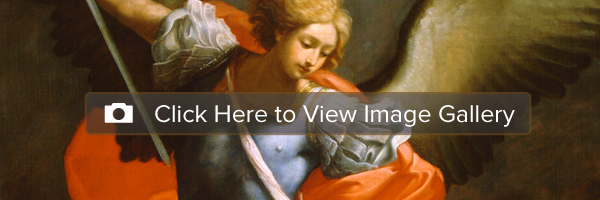
Early 16th-century Netherlandish artists displayed a number of diverging styles that both assimilated Primitive masters of the previous century and looked to Italian art for inspiration.
Northern artists studied in Italy and returned to their homelands disseminating the Italian Renaissance and Mannerist styles. Although northern art acquired regional characteristics, it still retained some of the core elements of the mannerist style, such as the decorative artificiality. The proliferation of prints, travel, and courtly patronage contributed to a multi-faceted display of artistic invention, especially in the realms of printmaking and genre painting.
Bob Jones Jr. the founder of M&G, began building the art collection in 1948. After Carl Hamilton, an art-expert and friend, suggested the idea to him, Dr. Bob discussed the possibility of a University Art Gallery with the Execut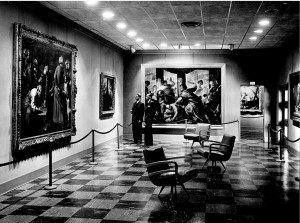 ive Committee. He pointed out that a collection of sacred art would be an excellent complement to the schools of Fine Arts and Religion. The Executive Committee agreed, established an acquisition fund, and empowered Dr. Bob to begin collecting art for the university. The criteria for collecting were determined, since every collection must establish its boundaries in order to create its own unique and useful niche: it would be limited to western religious art.
ive Committee. He pointed out that a collection of sacred art would be an excellent complement to the schools of Fine Arts and Religion. The Executive Committee agreed, established an acquisition fund, and empowered Dr. Bob to begin collecting art for the university. The criteria for collecting were determined, since every collection must establish its boundaries in order to create its own unique and useful niche: it would be limited to western religious art.
Because Baroque art was unpopular with museums and collectors in the 1950s, Dr. Bob was able to purchase a number of fine paintings his first year of collecting at astonishingly low prices. The Gallery’s original collection comprised twenty-five paintings and included works by Botticelli, Botticini, Ghirlandaio, Tintoretto, Veronese, and Ribera. These paintings were displayed for the first time on Thanksgiving Day 1951 in a two-room gallery adjoining the Bowen Collection of Antiquities.
After the Gallery’s inauguration, the collection rapidly grew. Three years later, in 1954, the collection had grown to 40 works. By 1962, it held 211 paintings, and by 1991, the Gallery had over four hundred works on permanent display. In 1963, the Gallery acquired seven important Benjamin West paintings from West’s large series “The Progress of Revealed Religion.” During this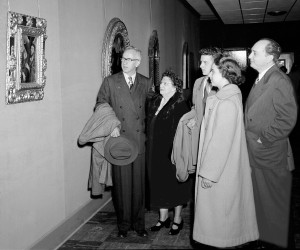 time of development, the Gallery also acquired the James Cole Collection of Ecclesiastical Textiles and Vestments, and began acquiring valuable furniture and the Russian Icon collection.
time of development, the Gallery also acquired the James Cole Collection of Ecclesiastical Textiles and Vestments, and began acquiring valuable furniture and the Russian Icon collection.
To accommodate additional artworks, the Gallery moved twice before 1970—first, in 1956 when the Fine Arts Building was constructed, and later, in 1965, when the University’s dining facility was moved. This second expansion of the Gallery into the former Dining Hall was an event of national importance that included a gala event for museum curators, art collectors, and other special guests from around the world.
In addition to collection catalogs published through the decades and museum curators and directors praising the collection, the Gallery gained increased national prominence when NBC Television broadcast a number of the paintings in three Project Twenty specials.
In 1996, the Gallery expanded further by becoming a separate, 501(c)(3), independent non-profit corporation called the Museum & Gallery, Inc. governed by its own board of trustees.
For more than 70 years, paintings from the Collection have been loaned to numbers of national and international exhibitions. In addition to these special loans, M&G continues to offer great art to the public through programming and outreaches.
Adapted from Standing without Apology: The History of Bob Jones University by Daniel L. Turner
Walnut with parcel gilt
Tuscan, 16th century
While the Museum & Gallery is most widely known for its collection of religious Old Master paintings, the founder of the museum also developed “supplemental collections of period furniture, icons, decorative arts, textiles, and objects of art” (Drama & Beauty: Great European Paintings from the Bob Jones Collection). The original intent of these sub-collections was to provide a setting for the artwork that would allow modern viewers to understand and appreciate the religious and domestic contexts in which the paintings might first have been displayed.
By the 1970s notable authorities of furniture considered these once-ancillary collections to rival some of the world’s best. Joseph Aronson, who wrote a number of authoritative histories of furniture, “considered the Renaissance furniture collection the finest in America” and lent his expertise to write a catalog containing Furniture in the Bob Jones University Collection, which was published in connection with M&G’s 25th anniversary celebration in 1976.
Specifically, this Italian Renaissance walnut and parcel-gilt Cassone epitomizes the history, breadth, and educational value of M&G’s period furniture collection. Purchased for the collection in 1966, the Cassone came from French & Company, in New York City. Founded in 1907, French & Company was once considered one of the world’s largest dealers and had provided art, furnishings, and even interior design to some of the best-known families of America’s Gilded Age, including the Vanderbilts, Astors, Gettys, Rockefellers, Mellons, and duPonts (and subsequently in the collections of the major museums endowed by those families). The company thrived under its first two generations of leadership and was noted for its library of documentation, which provided purchasers with exhaustive histories (or provenance) of the items acquired. The company was then sold several times, and much of its remaining stock was auctioned in 1968. M&G is pleased to provide a home for a number of French & Company pieces.
The history of cassoni dates back to the fourteenth century. Originally functioning as wedding chests for new couples—and paraded through the streets in wedding procession—cassoni often contained the bride’s dowry and became cherished treasures in newly established homes. The decoration of cassoni grew in sophistication over the years and entire workshops were devoted to the artform. Frequently portraying Biblical, classical, or mythological subject matter, the front panels of these chests displayed any number of craftsmanship, from carving and gilding to built-up gesso decoration and painting. Even notable artists such as Sandro Botticelli, Paolo Uccello, and Donatello applied their skills to decorate cassoni for the wealthiest clientele.
M&G’s Cassone likely dates from 16th-century Tuscany and is constructed of carved walnut. Standing on diagonally-set lion paws, the chest’s special features include gilded gadrooning, the detailed and deeply-set carving on the front and side panels, as well as the ogee dome molding. The unique top paired with the end panels shifts the most intricately carved subject matter to the front of the chest and only the front two-thirds of each side (figure 1). This technique differs from the usual appearance of cassone, which are most often depicted at the foot of a couple’s bed in Renaissance art. It’s likely that this particular cassone was commissioned to solve a specific architectural challenge in its new home—possibly resting in the shallow recess of a wall or passageway. As such, it is not typical of the traditional traveling chest, but represents “a step in the evolution of the credenza form” (Aronson).
Also of interest, the remarkably dimensional, carved frieze (figure 2) has been variously explained as a battle scene or a depiction of Death riding an ox-drawn chariot through a sacrificial scene. The key clues in the frieze include bystanders observing the action from the safety of colonnades on the left and right. Most prominently on the front left is a woman holding a round vessel and a man who appears to be strangling a sheep held aloft in front of him. The front right draws the viewer’s focus to a king, surrounded by an entourage. The central figure in the scene is indeed a man on an ox-drawn chariot, riding through a plain, which is covered by furrows and ridges. Near him are 5 warriors with weapons drawn. More difficult to see in the distance above him on the plain (moving from left to right) are a ridged-back dragon, a tree, and a walled city on a hill.
Since cassoni often depict a felicitous message for newlyweds, using classical, biblical, or mythological imagery, deciphering the elements is a fascinating undertaking. In the case of this M&G cassone, newlyweds are reminded of the exploits and love contained in the story of Jason and Medea. While there are many Greek and Roman variations of the story, the key elements remain.
Jason’s father was the rightful king of Iolcus, but was overthrown by his half-brother, Pelias. Jason’s life was saved by his mother, who sent him away to be protected and educated by the centaur Chiron. When Jason returned and wished to re-take the throne, Pelias required that he undertake a quest to find and return the Golden Fleece from where it lay in Colchis. After a series of adventures Jason and the crew of his ship Argo (hence the collective name Argonauts) arrived in Colchis, where Jason requested the fleece from King Aietes. Aietes agreed to give Jason the Golden Fleece if he accomplished three feats of bravery intended to be deadly to Jason. Unknown to the king, his daughter, Medea, was charmed to fall in love with Jason and help him survive and succeed.
First, Aietes required that Jason plow a field with fire-breathing oxen, but Medea gave him an ointment to protect him from the flames. Jason next had to sow the field with dragon’s teeth. When he did so, the teeth turned into full-grown warriors (spartoi). They would have killed Jason, had he not been told how to defeat them. He threw a stone into their midst and the confused warriors, not knowing who had thrown the stone, attacked each other.
Finally, Jason had to retrieve the Golden Fleece from where it hung on an oak in the sacred grove of Ares. The grove was protected by an undying, unsleeping dragon. Here again Medea protected Jason by administering an herbal potion that made the dragon sleep. Finally, the hero and his love Medea flee from her father and return to take the Iolcus throne from Jason’s uncle. Unfortunately, their happiness was short-lived; but that part of the couple’s story is—understandably—not portrayed by the artisan of this very special Cassone.
Dr. Stephen B. Jones, M&G volunteer
Sources
Aronson, Joseph. Furniture in the Bob Jones University Collection. 1976.
Drama & Beauty: Great European Paintings from the Bob Jones Collection. Museum & Gallery, Inc. in association with D. Giles Limited, 2022.
Published 2024
https://www.youtube.com/watch?v=MI3OASln4T0&nohtml5=False
https://www.youtube.com/watch?v=VlnqOluwKBQ&nohtml5=False
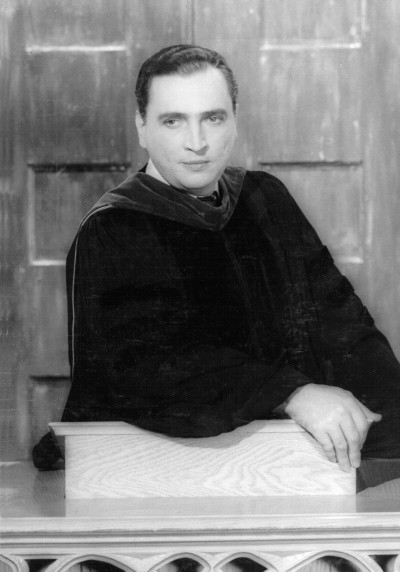 Dr. Bob Jr. began preaching while serving as Acting President during his father’s absences. When his father was away, part of Dr. Bob’s responsibility was to preside over or preach at the daily chapel service. He was not a trained theologian, so to prepare for these preaching opportunities, he began reading some of the great works of systematic theology, sermons of the Puritan divines and the sermons of some contemporary preachers. In the mid-1930s, Dr. Bob began preaching regularly in campus chapel services and began to be invited to preach at revivals and young people’s meetings. By the late thirties he was highly sought as a preacher.
Dr. Bob Jr. began preaching while serving as Acting President during his father’s absences. When his father was away, part of Dr. Bob’s responsibility was to preside over or preach at the daily chapel service. He was not a trained theologian, so to prepare for these preaching opportunities, he began reading some of the great works of systematic theology, sermons of the Puritan divines and the sermons of some contemporary preachers. In the mid-1930s, Dr. Bob began preaching regularly in campus chapel services and began to be invited to preach at revivals and young people’s meetings. By the late thirties he was highly sought as a preacher.
Eventually, Dr. Bob’s preaching career took him to every inhabited continent in the world and every state in the union. He preached to millions of people and saw many thousands converted to Christianity.
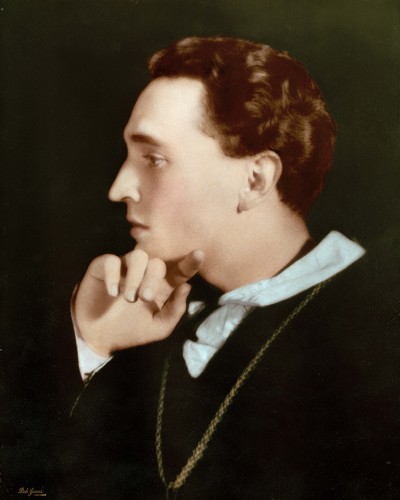 In 1936, the distinguished actor Otis Holmes Skinner (1858-1942), encouraged Dr. Bob Jr. to make a career in theatre. He did not take Skinner’s advice, but he did develop a one-man show. Known as “Curtain Calls,” the show was performed in “authentic costumes and makeup, [with] special stage setting and lighting effects,” and accompanied by classical music on the piano or organ. It was scheduled for four weeks of performances each year until December 1945, and brought acclaim to Jones Jr. as a Shakespearean interpreter. One critic wrote, “What a joy to have a Hamlet that is young, alive, and good-looking. Bob Jones brings to the part youth, fire, and fine acting.”
In 1936, the distinguished actor Otis Holmes Skinner (1858-1942), encouraged Dr. Bob Jr. to make a career in theatre. He did not take Skinner’s advice, but he did develop a one-man show. Known as “Curtain Calls,” the show was performed in “authentic costumes and makeup, [with] special stage setting and lighting effects,” and accompanied by classical music on the piano or organ. It was scheduled for four weeks of performances each year until December 1945, and brought acclaim to Jones Jr. as a Shakespearean interpreter. One critic wrote, “What a joy to have a Hamlet that is young, alive, and good-looking. Bob Jones brings to the part youth, fire, and fine acting.”
In 1934, when Dr. Bob was twenty-three, Asbury College in Wilmore, Kentucky, awarded him an honorary doctor of letters degree for his work as a Shakespearean actor. The Shakespeare Association of America invited him to present Curtain Calls at their 1935 annual convention, and he was hailed by the International Lyceum Association as the “best young actor of Shakespeare in America.”
Walnut and pastiglia
Italian, 15th century
The antique furnishings in the Museum & Gallery collection elevate each visitor’s experience of the artwork on the walls, but the pieces also provide a historical context of the eras and cultures from which the artworks sprang. Indeed, the furnishings are also artworks in themselves.
This is certainly true of the many cassoni (plural of the Italian term for “chests”) in the collection. Like other furnishings in Renaissance homes, the quality of workmanship and materials employed in decorating each cassone convey a great deal about the fashion of their times, the technologies available to craftsmen, and the wealth and social status of their owners.
Unfortunately, much has gone against their survival to our day. Cassoni were used for storage of personal items, opened and closed numerous times over the years. That wear, along with the environment in a home, infestations of termites, dry rot, changes in taste and reversals of family fortunes all conspire against the preservation of these furnishings.
These rich, showy Italian types of chests became widespread in Northern and Central Italy, particularly Tuscany (with a number of the best artists hailing from the cities of Siena and Florence). Weddings served as the occasions for which cassoni were made, and they were in fashion from the 14th-16th centuries, a period spanning the very late-Middle Ages to the beginning and middle of the Renaissance. The oldest surviving cassoni feature primitive panel designs, while later works demonstrate lavish carving, gilding, polychrome, and more complex narrative scenes.
Much like moving trucks, boxes, and barrels accompanying the establishment of new homes, cassoni had a very specific use. Practically speaking, the chests were designed to contain the bride’s dowry and jewels, her family’s contribution to the marriage, and became one of the couple’s most important household furnishings—often at the foot of the bed. They quite literally became a vehicle displaying the status, wealth and sophistication of the intermarrying families, carried in a procession (the domum ductio) from the bride’s parent’s home to her groom’s abode.
Decoratively speaking, cassoni often feature heraldic imagery relating to the families’ crests, and the pictorial panels often contained biblical, mythological, or allegorical imagery which ranged from learned and literary to humorous and light-hearted. Cassoni themselves were so common in the early- and middle-Renaissance that they’re included in Old Master paintings (most familiar may be scenes of the Annunciation in which Mary is seated on or kneeling near a cassone situated at the foot of her curtained bed) and even picture-within-picture vignettes on cassoni panels themselves.
This particular M&G cassone entered the collection in 1957, and its features suggest a date very early after 1400, likely from Tuscany. Unlike many cassoni today, which have the panels removed and presented as separate works of art in their own right, our chest is in good original condition and is structurally sound, despite surviving 600 years of use and change. The lid is still attached with its original hinges and has a simple locking mechanism. While the lid opens and closes easily, the tight fit and years of use have worn off some of the gesso along the top edge.
Composed of thick walnut planks and framing, the chest has a large front center panel decorated with gilt and polychrome over trellis-embossed gesso. Heraldic lions (possibly leopards or even hunting dogs) face each other across the front, and the two vertical end panels blossom with delicate arabesques and outline colored shields, which likely contained familial coats of arms.
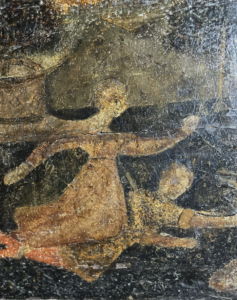 Carved, fluted pilasters frame the two pictorial end panels and are topped with vague Corinthian capitals. The primitive-style narrative at the right end is now entirely obscured, but the imagery at the opposite end remains. The subject matter is indistinct and may be biblical or mythological. Most likely, perhaps, it is the myth of Diana (Artemis) and Actaeon, from Ovid’s Metamorphoses, in which the bathing goddess is startled by a young hunter. In her anger, Diana turns Actaeon into a stag who is then hunted and killed by his own hounds. This identification seems to make sense of the simplistic representation of forest, pool, a stag’s head (lower right) and a hound in the left background. As an allegory or fable for a young couple, it may emphasize modesty, self control, and consequences for the lack of either or both.
Carved, fluted pilasters frame the two pictorial end panels and are topped with vague Corinthian capitals. The primitive-style narrative at the right end is now entirely obscured, but the imagery at the opposite end remains. The subject matter is indistinct and may be biblical or mythological. Most likely, perhaps, it is the myth of Diana (Artemis) and Actaeon, from Ovid’s Metamorphoses, in which the bathing goddess is startled by a young hunter. In her anger, Diana turns Actaeon into a stag who is then hunted and killed by his own hounds. This identification seems to make sense of the simplistic representation of forest, pool, a stag’s head (lower right) and a hound in the left background. As an allegory or fable for a young couple, it may emphasize modesty, self control, and consequences for the lack of either or both.
This cassone provides insight into the artistry, fashion, and domestic life of those living in the early years of the Italian Renaissance and is a valuable part of the M&G collection.
Dr. Stephen B. Jones, M&G volunteer
Additional Resources:
The Oxford History of Western Art. Kemp, Martin, ed. Oxford University Press, 2000.
Pooley, Eugene. “Scenes from a Marriage.”
https://blog.dorotheum.com/en/classic-week-florentine-school/
https://www.medieval.eu/bridal-chests-or-cassoni-from-medieval-italy/
Published 2023
Oil on panel, c. 1529–30
Florentine, 1486–1530
Andrea d’Agnolo grew up in Florence and was nicknamed del Sarto meaning “of the tailor” after his father’s profession. Like other early Renaissance artists, he initially trained with a goldsmith, then studied under a series of three separate painters until he began producing his own works in 1506. He spent most of his life in Florence—except for a visit to Rome and a brief stint as court painter to King François I at Fontainebleau in 1518.
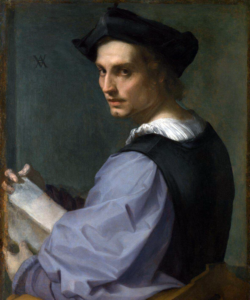 As the son of a tailor, del Sarto’s works reveal a unique understanding and love of fabrics—even seen in his 1517-1518 Portrait of a Young Man in London’s National Gallery, which may be a self-portrait (on right). Notice the finishes of the puffed sleeve, ruched white undershirt, and the vest’s seam at the shoulder.
As the son of a tailor, del Sarto’s works reveal a unique understanding and love of fabrics—even seen in his 1517-1518 Portrait of a Young Man in London’s National Gallery, which may be a self-portrait (on right). Notice the finishes of the puffed sleeve, ruched white undershirt, and the vest’s seam at the shoulder.
Andrea was also influenced by his contemporaries who outlived him: Leonardo da Vinci, Michelangelo, and Raphael. Once these masters left Florence for other parts of Italy, Andrea became Florence’s leading artist in the early 1500s. He is overlooked in art history; yet he is equal in skill and quality to the three greats, and his works are beautiful and still revered today. Julian Brooks, curator of drawings at the Getty, recognizes del Sarto as the “revolutionary engine of the Renaissance and the transformer of draughtsmanship” due to his careful and creative preparatory drawings, a practice which inspired the next generations of artists to follow.
However, he has been underappreciated, even to the point of his students overshadowing him to become famous including Rosso Fiorentino, Jacopo da Pontormo, and Giorgio Vasari, biographer of contemporary Renaissance artists. Vasari records details about his teacher as related to M&G’s work. A Florentine charitable organization for plague victims, the Company of St. Sebastian commissioned Andrea del Sarto to paint a picture of St. Sebastian, the patron saint for plague victims. He became a member of the Company in February 1529, perhaps as a result of negotiations surrounding the commission. Ironically, shortly after completing the painting in 1530 during Florence’s plague epidemic, del Sarto died from the plague at 44 years old.
Several 17th-century documents list the original St. Sebastian as the property of the Company of St. Sebastian. Publications in 1759 and 1770 mention that the painting moved to the Pitti Palace in Florence. By the early 19th century, writers could no longer trace the location of the original painting—apparently it was removed from the Pitti Palace and lost.
M&G acquired St. Sebastian in 1970 from the former great British collection of the Cook family. In 2005, the National Gallery of Canada requested St. Sebastian to participate in an exhibition, and we sent our work in advance for study and conservation. The conservator Stephen Gritt found, “In its materials and construction, the painting is entirely consistent with one from Sarto’s workshop. The complete absence of any change in the design from the drawing stage on the panel through to the painting would indicate perhaps that the design had reached a point of satisfactory refinement by the time this version was produced. While this may mean that some artist other than Sarto could have painted the work, it does not exclude his participation in its production as a supervisor.”
Regarding del Sarto’s workshop practice, Julian Brooks notes that “Andrea would have been closely involved in the production of all versions, or at least those produced in his workshop during his lifetime, and these were produced side by side in the studio.” He also made, used, and reused partial cartoons.
It is difficult to confidently confirm if M&G’s St. Sebastian is the missing painting by the master, thus the current attribution, studio of Andrea del Sarto. At the least, someone very close to del Sarto painted the work. Found in Italy, Spain, England, and Austria, more than 10 other variants of the St. Sebastian exist. Even so, M&G’s is considered by specialists as the “best surviving reflection of the original.”
Erin R. Jones, Executive Director
Published 2023